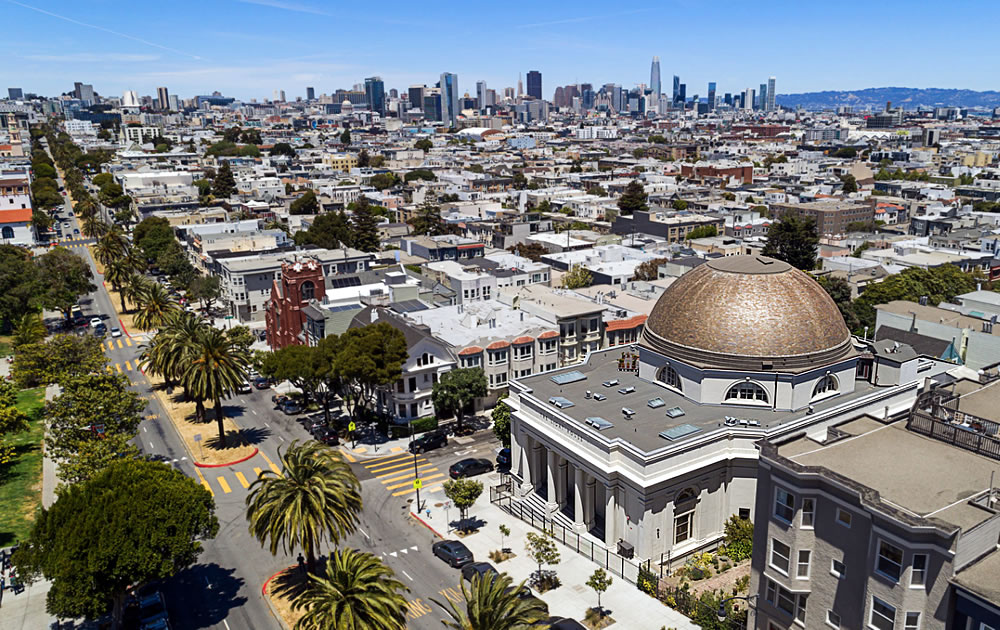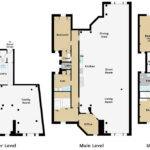Totaling over 5,300 square feet of space, 93 Cumberland Street is one of the four massive “Light House” condos that were created when the former Second Church of Christ at 651 Dolores Street, which overlooks Mission Dolores Park, was redeveloped in 2016.
Featuring a central great room with a 30-foot ceiling, exposed brick walls, polished cement floors, steel beams and original and repurposed woodwork throughout, the three-level unit “in the center of it all” was purchased for $6.1 million in February of 2017, which was $49K under asking and in-line with the other units in the building and neighborhood.
Having unsuccessfully returned to the market priced at $5.995 million in June of last year, a price which was reduced to $5.395 million this past April, the list price for 93 Cumberland has just been reduced to $4.95 million, a sale at which would be considered to be “at asking” according to all industry stats and aggregate reports but would be 18.9 percent below its 2017 value on an apples-to-apples basis.
If you think you know the market for high-end units around Dolores Park, now’s the time to tell.











It’s a beautiful place. Too bad the sellers are losing money, but in the same way its “too bad” that many assets have declined in value.
Given how much securities markets (and specifically SF Bay area technology companies) are down since their covid peaks, for an asset to drop in value here is not surprising.
The interesting part of the equation for me at the moment is that one of the typical arguments for real estate is that as “hard assets” RE should do well in inflationary times. That clearly hasn’t been the case.
Real Estate assets are behaving more liked fixed-coupon bonds, (going down based on what people can afford to pay via financing), rather than floating rate bonds (where one assumes income will float higher in the future based on extrapolated inflation leading to higher rents.) I think the answer will eventually be somewhere in between.
Those who bought “overpriced” homes in the 2015-2021 period with very low single digit 30Y mortgages and stay put will be laughing all the way to the bank.
“Those who bought “overpriced” homes in the 2015-2021 period with very low single digit 30Y mortgages and stay put will be laughing all the way to the bank.”
those houses will never see the prices they paid again in their lifetime as interest rates normalize and are never going back to 0.
until the next recession… The politicians keep playing this game, they don’t want a recession, reduce interest rates, pump the economy with free money, and thus the richer get richer, and the inflation is just a tax on poor people.
Maybe not, but the people who live in those houses will be making low monthly payments and then they own their homes, instead of paying rent and owning nothing.
I’m one of those people who have been paying rent for years and own nothing…but the shares purchased with the money I had saved for a down payment. Market has taken a hit but my portfolio is still worth 3-4x the condo I was trying to buy 15 years ago. Not for everyone but best financial decision of my life.
Congratulations! I don’t think everyone is as good at picking stocks as you are.
Not everyone is great at picking individual stocks, but keep in mind that the return from indexed funds has outperformed the return on real estate over the years. And if you happen to be tech focused, it’s been by a wide margin. Which brings us back to the property and trend(s) at hand…
the stock market has done very well for past 13 years, so 3-4X is not unreasonable. general index funds up >2.5x. housing market of course also on a tear, especially if you used a very low mortage with only 20% down. way more upside than paying cash for homes
Yes, the market has done well, but one must then subtract from those gains the amount that you pay in rent, and then also deduct the tax benefits from mortgage interest, which used to be very significant. So looking at just the stock market versus just the value of real estate is not the correct measure.
“Real Estate assets are behaving more liked fixed-coupon bonds, (going down based on what people can afford to pay via financing), rather than floating rate bonds (where one assumes income will float higher in the future based on extrapolated inflation leading to higher rents.) “
It’s almost as if the organic demand remaining after ZIRP/QE-fueled speculation comes to an end isn’t sufficient to maintain asset bubble price increases. There must be a lesson here – one that we’ve learned and forgotten several times before over the years – but damned if I can figure it out! 😂
“Those who bought “overpriced” homes in the 2015-2021 period with very low single digit 30Y mortgages and stay put will be laughing all the way to the bank.”…
…after thirty years, which is fine and as it should be, as opposed to, say, a 50% gain after holding for two years.
Abstractly and in general holding a low interest mortgage in times of inflation should be good for RE holders.
But we’re talking about RE in San Francisco specifically and in specific neighborhoods after a very large run up. A big variable in future values will be how the city of SF and state of CA handle things over time and whether there is outsized demand to live here.
Just like a good economy is good for stocks in hot market sectors, but a poorly run specific company can totally blow it. But maybe if a sector is so high growth, a badly run company can still be wildly successful. Hard to say!
As we outlined at the end of last year, the specter of multiple rate hikes this year “should translate into higher mortgage rates, less purchasing power for buyers and downward pressure on home values,” none of which should catch any plugged-in readers by surprise.
Which brings us back to the property and trend at hand…
I think it is unlikely it will take anywhere near 30 years to reclaim recent price peaks in nominal terms.
I agree that the low interest rate policies of the past four decades have been a huge boon to those capable of borrowing and paying back borrowed money.
Here is what will happen:*
We will face an economic recession in 2023 (mild-ish, it seems now).
Some people will be out of work. A number of people who have elected not to go back to work since the pandemic will finally come around and get jobs again.
Once the recession and people coming back into the workforce starts to impact (diminsh) inflation rates, the Fed will declare victory, and then “save the American economy” by lowering interest rates again. One can be Paul Volcker and Alan Greenspan in the same term!
By that time we will be back in an environment of lower house prices, friendlier rates for borrowers and the sun will continue to shine. Real Estate prices rally.
(Here’s the part where I wait for a sanctioned, bizarre, ad hominem attack on Real Estate professionals.)
*This is 100% for sure going to happen. After all, you read it on the internet.
Some people will be out of work. A number of people who have elected not to go back to work since the pandemic will finally come around and get jobs again.
Why? Why exactly will these people “come around”, since a recession wouldn’t seem to affect people who aren’t working in the first place. And even if they want to work, wouldn’t a recession be the worst possible time to have this epiphany ??
So, the “fix” to a crashed asset bubble is to re-inflate the bubble using the same methods that created the bubble in the first place.
You may be right, and I suspect that the Fed’s objective is indeed to crush upward wage pressure at the bottom while easing off asset inflation at the top just a little, but as Piketty, Minsky, Keynes, and a bearded dude named Karl variously showed, the frequency and severity of asset bubbles increase until systemic collapse is unavoidable. Whether this current downturn leads to a new depression remains to be seen, but I think we will see increasing systemic precariousness as the inevitable result of the asset bubble-blowing policies of the forty-year neoliberal dispensation sooner rather than later. Now is a great time to be an asset broker for bespoke bugout shelters in New Zealand and Montana!
“So, the “fix” to a crashed asset bubble is to re-inflate the bubble using the same methods that created the bubble in the first place.”
100%
Yes. That is what central banks have taught economic actors to expect.
After internet bubble 1.0
After GFC
After Covid scare
The policy change cannot be co-opted by congresspeople. It is effective in stimulating economic growth. People grow richer by understanding it.
The policy does not result in a more equal, more just society. It is how the world has worked in recent decades.
I agree with you that this “is what central banks have taught economic actors to expect” and that “[p]eople grow richer by understanding it.”
I agree that “policy change cannot be co-opted by congresspeople,” but even if they could, I see no evidence that our political class has any desire to change the ongoing policy of upward transference of wealth.
I also think that continuing these policies will end very badly for most people, including many of those who have done very well by them so far.
Don’t be so hard on central banks! They only have two buttons to push. One button prints money. The other button raises or lowers interest rates.
It’s not like they can employ people, fire them, produce more beanie babies in China or pump more oil in Saudi Arabia, or really do a single thing that would directly impact inflation, deflation, employment or anything else.
The bank has two buttons. The Fed pushes the buttons when they feel the need to. Repeat ad infinitum until the wheels fall off.
The only way this breaks down is the United States is no longer the world’s superpower and can’t cram their dollars down everyone else’s throats. And that’s not going to happen in 2022. We still rule the world and everything is as it should be.
Almost correct, the fed can also reduce/tighten money supply
This was originally designed as special purpose building (religous use), and I believe might have been historically landmarked. Those kind of properties don’t lend themselves well to adaptive re-use. Its difficult to draw conclusions and project onto other residential properties. But another data point that market values don’t always go up.
With the slide show of interior photos, can somebody explain what is going on with the 7th pic? What is happening there?
You mean those burly steel structures to the right? That’s part of the retrofitted seismic moment frame to keep this from becoming a pile of bricks during the next big quake.
Looks like dungeon play space that’s been staged to look like something else for marketing.
I got to tour one of these units when the poor real estate agents decided to have an open house. Let’s just say the appeal is limited. The bedrooms are smallish and far away from everything; there is weird space on the bottom floor; it’s more of a party pad than a place to live. For $6 million or even $5 million you can get a really nice house. So these units appeal only to people who have that kind of money but don’t want a really nice house.
How do you heat and cool such a dwelling?
I could see this being a great place for a Founder/CEO to run a live/work loft. Office during the week, parties on the weekend…
Except it’s not zoned for that and I don’t think it would be legal.
Actually I think somebody in one of these units was trying to do just that, essentially, several years ago, and I think it got shut down.
Always wondered why they went with 4 massive (and very niche) condos vs a dozen smaller ones. Maybe there was an aspect to the layout/retrofit that made it economically unfeasible to subdivide it further?